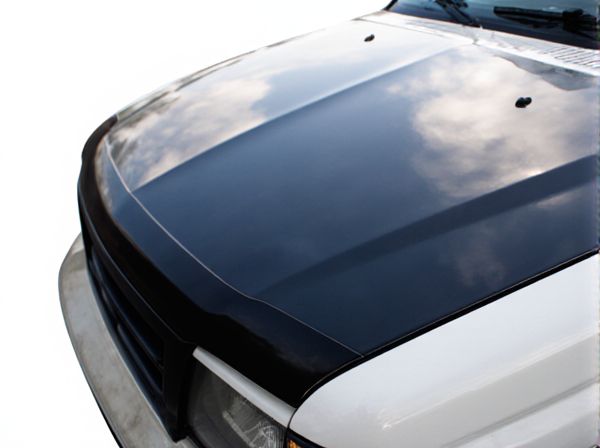
Photo illustration: Power Bulge Hood vs Flat Hood
A power bulge hood features a raised central section designed to accommodate larger engines or enhance airflow, offering improved performance and aggressive aesthetics. Flat hoods provide a sleek, streamlined look that suits minimalist designs and classic vehicles, prioritizing visual simplicity over extra clearance. Your choice depends on whether you want enhanced engine capacity and a muscular appearance or a smooth, understated style for your vehicle.
Table of Comparison
| Feature | Power Bulge Hood | Flat Hood |
|---|---|---|
| Design | Raised center section for engine clearance and aggressive styling | Flat, smooth surface for a clean, minimalist look |
| Engine Compatibility | Supports larger or high-performance engines with extra clearance | Best suited for standard or smaller engines |
| Aerodynamics | May slightly increase drag due to raised profile | Offers better aerodynamic efficiency with smooth surface |
| Weight | Typically heavier due to extra material and reinforcement | Lighter due to simpler, flat design |
| Style Impact | Enhances aggressive, muscular vehicle appearance | Provides understated, sleek exterior look |
| Maintenance | More complex to clean and repair because of contours | Easier to maintain due to flat and simple surface |
Introduction to Power Bulge Hood vs Flat Hood
Power bulge hoods feature a raised center section designed to accommodate larger engines or enhance airflow, providing both functional and aggressive aesthetics commonly seen in performance vehicles. Flat hoods offer a clean, streamlined look that emphasizes simplicity and uniformity, often preferred for classic or minimalist car designs. The choice between a power bulge hood and a flat hood depends on engine clearance needs, aerodynamic considerations, and desired visual impact.
Aesthetic Appeal: Visual Impact Comparison
Power bulge hoods create a pronounced, muscular visual impact by adding height and contour to a car's profile, emphasizing strength and performance. Flat hoods provide a sleek, minimalist appearance that enhances a vehicle's aerodynamic look and modern styling. The choice between power bulge and flat hoods significantly influences the car's aesthetic appeal, aligning with either aggressive sportiness or streamlined elegance.
Aerodynamics: Performance Differences
Power bulge hoods enhance engine clearance while subtly disrupting airflow, creating additional drag compared to flat hoods. Flat hoods provide a smoother, more streamlined surface that reduces aerodynamic resistance and improves high-speed stability. The aerodynamic advantage of flat hoods often results in better fuel efficiency and faster acceleration in performance vehicles.
Engine Clearance and Fitment
A Power Bulge Hood offers increased engine clearance, making it ideal for vehicles with larger or modified engines that require additional space. In contrast, a Flat Hood provides a sleek and low-profile appearance but may restrict fitment options for engines with taller components. Proper engine clearance under the Power Bulge Hood ensures optimal fitment and prevents interference with aftermarket parts or forced induction systems.
Cooling and Heat Management
Power bulge hoods feature a raised center section that enhances engine cooling by allowing more air circulation and heat dissipation, making them ideal for high-performance vehicles. Flat hoods offer a sleek design but may trap heat more easily, reducing airflow and potentially increasing engine temperatures during intense driving. Effective heat management is crucial in power bulge hoods due to their open vents or scoops, which actively channel hot air away from the engine bay to maintain optimal performance.
Weight and Material Considerations
Power bulge hoods typically weigh more due to their raised structure, often constructed from heavier steel or fiberglass materials to ensure durability and heat dissipation. Flat hoods generally use lighter materials such as aluminum or carbon fiber, reducing overall vehicle weight and improving performance. Selecting between a power bulge hood and a flat hood requires balancing weight impact with material strength and heat management needs.
Installation and Compatibility Issues
Power bulge hoods often require specific mounting hardware and may need modifications to the existing hood latch system, resulting in longer installation times compared to flat hoods. Flat hoods generally offer better compatibility with a wider range of vehicles due to their simpler design and standard dimensions, reducing the risk of fitment issues. Vehicle models with aftermarket components or custom engine setups might face clearance problems with power bulge hoods, making flat hoods a more straightforward option for compatibility and ease of installation.
Cost Comparison: Budget Considerations
Power Bulge Hoods typically cost more than Flat Hoods due to their complex design and materials, often ranging 20-30% higher in price. Flat Hoods are generally favored in budget-conscious builds because of their simpler manufacturing process and lower material expenses. Choosing between the two depends on balancing aesthetic preferences and performance with the available budget constraints.
Resale Value and Market Demand
Power bulge hoods typically command higher resale value due to their aggressive styling and enhanced engine clearance, attracting enthusiasts and buyers seeking performance-oriented vehicles. Flat hoods often appeal to a broader market segment prioritizing a sleek, minimalist look, which can lead to steadier demand but potentially lower resale premiums. Market demand favors power bulge hoods in performance and sports car niches, while flat hoods maintain consistent appeal in commuter and luxury segments.
Choosing the Right Hood for Your Vehicle
Choosing the right hood for your vehicle depends on both aesthetic preferences and functional needs; Power Bulge hoods are ideal for enhanced engine clearance and aggressive styling, often benefiting muscle cars or trucks with high-performance engines. Flat hoods provide a sleek, minimalist look that complements modern, streamlined vehicle designs while maintaining aerodynamic efficiency and ease of customization. Assess the compatibility of hood design with your engine bay dimensions, heat dissipation requirements, and overall vehicle style to make an informed decision.
 caratoz.com
caratoz.com